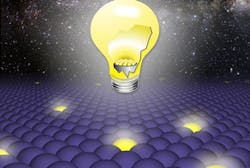Quantum-dot blinking mysteries revealed by LANL researchers
Los Alamos, NM--Los Alamos National Laboratory (LANL) scientists have made significant progress in understanding the phenomenon of quantum-dot blinking. Their findings should enhance the ability of biologists to track single particles, enable technologists to create novel light-emitting diodes (LEDs) and single-photon sources, and boost efforts of energy researchers to develop new types of highly efficient solar cells using quantum dots. The research was published in the journal Nature.
The most exciting finding is that blinking can be controlled and even completely suppressed electrochemically. The LANL researchers developed a novel spectro-electrochemical experiment that allowed them to controllably charge and discharge a single quantum dot while monitoring its blinking behavior. These experiments facilitated the discovery of two distinct blinking mechanisms. "Our work is an important step in the development of nanostructures with stable, blinking-free properties for applications from light-emitting diodes and single-photon sources to solar cells," said Victor Klimov, LANL scientist and director of the Center for Advanced Solar Photophysics (CASP).
The tiny dimensions of quantum dots—between 1-10 nm in diameter—allow scientists to produce particles with finely tunable, size-dependent electronic and optical properties. Together with the fact that they can be fabricated by means of facile wet-chemistry techniques, their quantum nature makes these dots attractive materials for a wide range of applications; however, quantum-dot optical properties can randomly vary over time, such as via quantum-dot "blinking."
Additionally, if energized by electrical current or light, they are characterized by an effect known as Auger recombination that both competes with light emission in light-emitting diodes and reduces current output in solar cells. Both blinking and Auger recombination reduce the efficiency of quantum dots, and controlling them has been the focus of intense research.
The first of two distinct blinking mechanisms is consistent with the traditional concept of quantum-dot blinking; that is, the random electrical charging and discharging of the core of the dot. In this model, a charged state is "dark" due to highly efficient nonradiative Auger recombination.
The second mechanism was a surprise; the majority of quantum dots blink due to the filling and emptying of a surface defect "trap" on the dot. If not occupied, this trap intercepts a "hot" electron that would otherwise produce photon emission, thus causing a blink. With further research into the photophysical properties of quantum dots, the scientists hope to provide a comprehensive theoretical model of this phenomenon.
"The new single nanocrystal spectro-electrochemistry technique developed here could readily be extended to study the effect of charging in a wide array of nanostructures, including carbon nanotubes and nanowires," said Han Htoon, a CINT staff scientist who took part in the research. "I believe that it will become an important new capability for CINT."
CASP is an Energy Frontier Research Center funded by the U.S. Department of Energy Office of Science, Office of Basic Energy Sciences. Its goal is to explore the unique physics of nanoscale materials to boost the efficiency of solar energy conversion through novel light-matter interaction regimes, controlled excited-state dynamics, and engineered carrier-carrier coupling.
SOURCE: LANL; www.lanl.gov/news/releases/researchers_unravel_the_mystery_of_quantum_dot_blinking.html

Gail Overton | Senior Editor (2004-2020)
Gail has more than 30 years of engineering, marketing, product management, and editorial experience in the photonics and optical communications industry. Before joining the staff at Laser Focus World in 2004, she held many product management and product marketing roles in the fiber-optics industry, most notably at Hughes (El Segundo, CA), GTE Labs (Waltham, MA), Corning (Corning, NY), Photon Kinetics (Beaverton, OR), and Newport Corporation (Irvine, CA). During her marketing career, Gail published articles in WDM Solutions and Sensors magazine and traveled internationally to conduct product and sales training. Gail received her BS degree in physics, with an emphasis in optics, from San Diego State University in San Diego, CA in May 1986.
